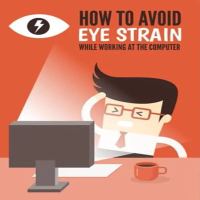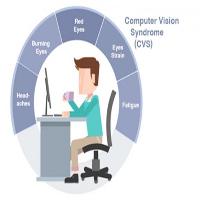As an optometrist, I often encounter
patients who complain about various
visual symptoms related to their use of
digital devices. This condition is known
as Computer Vision Syndrome (CVS),
a term used to describe a group of eye
and vision-related problems that result
from prolonged use of digital devices
such as computers, smart phones ,
tablets, and televisions.

In this blog post, I will explain what CVS is, how digital devices affect your vision,
and provide tips on how to protect your eyes from CVS.
CVS is a type of eye strain that occurs when you stare at digital screens for extended
periods without taking breaks or adjusting your viewing habits. The symptoms of
CVS include:
Eye Strain: Eye strain is a feeling of discomfort or pain in the eyes that can occur
after prolonged use of digital devices. This can be caused by the blue light emitted
from digital screens, which can penetrate deep into the eye and cause damage to the
retina.
Headaches: Headaches are a common
symptom of CVS and can be caused by eye
strain, fatigue, or flickering screens. This can
be especially common when using digital
devices for extended periods.
Blurred Vision: Blurred vision is a common
symptom of CVS and can occur when your
eyes have to work harder to focus on the screen. This can lead to difficulty focusing
on near objects and can result in a blurred or double vision.
Dry Eyes: Dry eyes are a common symptom of CVS and can occur when you don't
blink enough while using digital devices. This can cause a lack of tears or moisture on
the surface of the eye, leading to a gritty or burning sensation.
Neck and Shoulder Pain: Neck and shoulder pain are common symptoms of CVS
and can be caused by poor posture when using digital devices. This can lead to strain
on your neck and shoulder muscles.
Back Pain: Back pain is a symptom of CVS that can be caused by poor posture when
using digital devices. This can lead to strain on your back muscles.
Light Sensitivity: Light sensitivity is a symptom of CVS that can be caused by the
blue light emitted from digital screens. This can make it difficult to see in bright light
or to adjust to changes in lighting.
Tired Eyes: Tired eyes are a symptom of CVS that can occur when your eyes are
fatigued from prolonged use of digital devices. This can cause a feeling of heaviness
or exhaustion in your eyes.
Difficulty Concentrating: Difficulty concentrating is a symptom of CVS that can
occur when your eyes are fatigued and your brain is struggling to process visual
information. This can lead to difficulty focusing on tasks and decreased productivity.
Irritability: Irritability is a symptom of CVS that can occur when you are experiencing
eye strain, headaches, and fatigue. This can lead to a feeling of frustration and
irritability with your surroundings.
Digital devices affect our vision in several ways. Firstly, they emit blue light, which
can penetrate deep into the eye and cause damage to the retina, leading to eye strain
and fatigue. Secondly, digital screens tend to flicker, which can cause eye strain and
headaches. Thirdly, the close proximity of the screen can cause eye muscles to work
harder, leading to eye strain and fatigue.
As an optometrist, I recommend the following tips to
protect your eyes from CVS:
Follow the 20-20-20 rule: Every 20 minutes, take a
break for at least 20 seconds and look at an object 20
feet away. This helps to reduce eye strain and fatigue.
Blink frequently: Blinking helps to lubricate the eyes,
reducing the risk of dry eyes. Make a conscious effort
to blink more frequently when using digital devices.
Adjust screen settings: Adjust the brightness, contrast, and font size of your screen
to reduce eye strain. Use a matte screen filter to reduce glare and reflections.
Use proper lighting: Use proper lighting to reduce eye strain. Position your digital
device in a way that reduces glare and reflections from surrounding lights.
Use blue light filters: Use a blue light filter on your digital device or wear blue light
blocking glasses to reduce blue light exposure and protect your eyes.
Practice good posture: Maintain good posture when using digital devices to reduce
strain on your neck, shoulders, and back. Position your digital device at a comfortable
distance and angle.
Get regular eye exams: Get regular eye exams to ensure that your eyes are healthy
and to detect any changes in your vision. An optometrist can recommend personalized
treatment options to manage CVS.

Take regular breaks: Take regular breaks from your digital devices to rest your eyes
and reduce the risk of eye strain.
In conclusion, CVS is a common condition that affects many people who use digital
devices. As an optometrist, I recommend following these tips to protect your eyes and
reduce the risk of CVS. If you experience persistent symptoms of CVS, please
schedule an appointment with an optometrist to receive a comprehensive eye exam
and personalized treatment plan.









